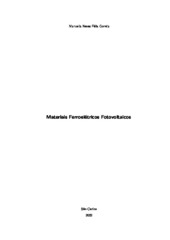Materiais ferroelétricos fotovoltaicos

Visualizar/
Data
2022-04-20Autor
Correia, Manuella Neves Félix
Metadata
Mostrar registro completoResumo
In this work, the characteristics of semiconductor and ferroelectric materials are analyzed.
in order to explore the functioning of photovoltaic cells made with one or
other material and compare them. The main objective of this study is to highlight the advantages
of the use of ferroelectric materials for this application. Start with an introduction
on intrinsic semiconductors, with an in-depth description of band theory and the
gap energy. Extrinsic semiconductors are presented, exploring the process of
doping and the influence of the emergence of acceptor and donor levels in the bandgap. is discussed,
also the p-n junction, a semiconductor device whose operation is the basis for the
understanding of a photovoltaic cell. The photovoltaic effect is also discussed and, finally,
All the concepts mentioned above are used to detail the operation of a
photovoltaic cell based on a semiconductor. Subsequently, materials are introduced
ferroelectrics, discussing the structural characteristics that govern their properties. Are
analyzed together the domain structure and the ferroelectric hysteresis curve, evaluating
its influence on the emergence of the depolarization field, which eliminates the need
to apply an external voltage so that the photovoltaic cell can generate a current
electricity, as in semiconductors. The operation of a
photovoltaic cell based on a ferroelectric material, comparing it with the previous cell.
Finally, the overview of the current market is analyzed, with a description
brief of commercial solar cell modules based on classical semiconductors, evaluating
production and energy efficiency. Therefore, characteristics that can be
be manipulated in ferroelectric materials in order to improve the photovoltaic response and the
energy efficiency of these materials.
Collections
Os arquivos de licença a seguir estão associados a este item:
